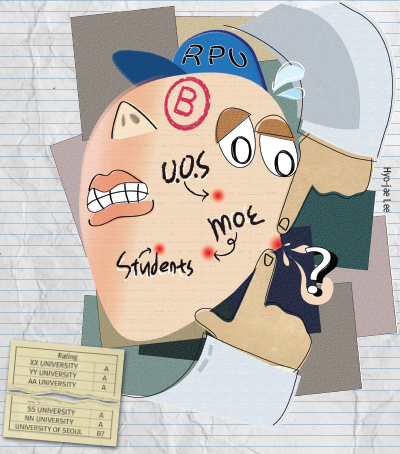
How did the UOS come to receive this result? What are the consequences of this rating for our school and other universities? The UOS Times attempts to answer these questions.
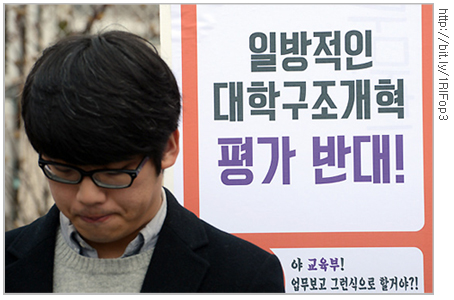
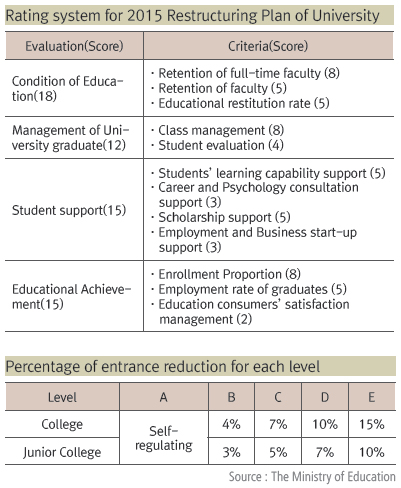
Contrary to the policy’s good intentions, controversies have surfaced at the UOS, because it obtained an unexpectedly low rating: B. Universities such as Kyunghee or Kookmin, which have commonly been considered as equivalent or lower, received ratings of A. Students submitted complaints about these results, and in addition, the Student Council issued a statement expressing dissatisfaction. Students and administration have attributed the rating to various factors. Some blame the administration for a passive reaction. According to The UOS Times, 86.8 percent of respondents answered the unfairness and dissatisfaction of level B. Others have criticized the MOE for unfair evaluation standards. Still others have sounded an alarm about the unstable support the UOS receives from the Seoul Metropolitan government, which has taken charge of the UOS budget.
The controversy has revealed not only problems with the new college evaluation system, but also chronic problems that the UOS has struggled against for some time. This entire situation has presented an opportunity to reconsider the direction of school development.
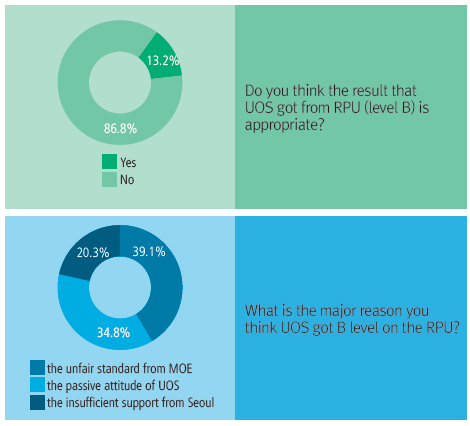
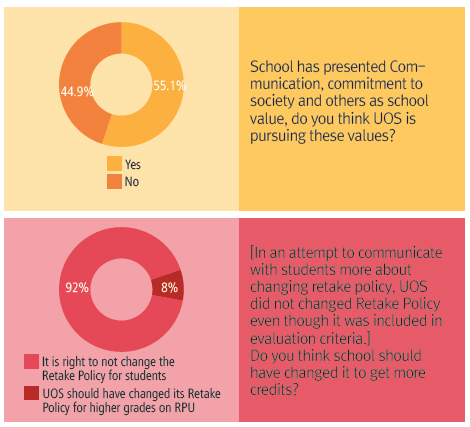
In response to the controversy nationwide over its new evaluation system, the MOE has been highly reluctant to make ratings and results known to the public. It has chosen instead to release data to individual universities on their own results. Neither The UOS Times nor its sister publication, UOS News, has been able to obtain published data from the MOE, which has repeatedly declined the phone calls requesting for the full details. However, the UOS administration has conducted internal analyses and studies of its own results. The administration has shared its conclusions with us. In addition, The UOS Times has conducted a survey to students on the controversy surrounding the MOE evaluation.
According to Won-seok Choi, deputy vice-president in the Office of Planning Affairs, there were two main sources of controversy: first, there was a cross-evaluation system through which professors of universities other than Seoul and metropolitan colleges evaluated the universities in Seoul and metropolitan areas and vice versa. The primary concern over this method is that it did not guarantee a correct judgment about the specializations or unique characteristics of the universities in both regions. Professors working at the universities near the capital could not thoroughly consider the specific situations and unique roles that the universities in the other provinces have, and the other way around held true. In one extreme reaction, the president of Kangwon National University resigned, strongly condemning the evaluation as unfair in that it failed to reflect its peculiar role in Kangwon area.
Also, the unequal portioning between the qualitative and quantitative components degraded the equity of the evaluation. For each section, qualitative standards took larger portions. Most universities showed very little deviation in responses to quantitative sections, so qualitative evaluations actually decided university ratings. During a parliamentary inspection of the evaluation, Dong-yeol Yeom, a member of the governing Saenuri party pointed out that Kangwon National University attained 40.046(97.7 percent) out of 41(100 percent) points in quantitative sections, but only 9.436(49.66 percent) out of 19(100 percent) points in qualitative items, yet the school scored an overall rating of D+. Although it may be true that qualitative criteria were an important addition to the evaluation, the large gap between quantitative and qualitative scores seemed unreasonable to many, and it should have been addressed.
Of course, a few defects in methodology do not nullify the evaluation’s positive effects overall. In response to the evaluation, the UOS has admitted that a revision of the career support system is needed. Regarding the job-finding programs provided by the school, the evaluation committee pointed out a poor feedback system. Choi also said that the feedback system was limited to gathering the student opinions. He added “The system has lacked a reflection of opinions on policy-making processes.” Regarding the start-up programs for students, Bo-mi Kim, from the Office of Planning Affairs, also agreed that very few of them had participated. She acknowledged that the school did not fully devote as many resources to the program compared to private universities, because the school presumably thought that student’s demand for the start-up program had been low.

The UOS has legal restrictions that make its systems and structures inflexible to change. Since the school’s budget is tight, and its usage is restricted, the A rating is rarely expected to be achieved in the college evaluation. Bo-mi Kim in the Office of Planning Affairs described the regulation-related challenges such that we have to put up with them every time a university evaluation comes up. The UOS is the public school run by the Seoul Metropolitan government, which imposes limits on spending. Budgets and rules regarding expenditure are decided through the city council, and it is this process that hinders rapid changes and/or corrections to fit the evaluation standards ahead of it. Private universities, on the other hand, have more effective and faster policy-making and implementation processes. For instance, the Metropolitan government’s half-tuition policy limits fiscal compensation to expenditures for school business. This regulation does not allow spending on personnel expenses, thus restricting the university’s ability to hire more administration and faculty. These limitations in turn have resulted in a failure to earn full credit for the section of the evaluation that assesses the number of full-time faculty. Based on an evaluation plan announced by the MOE in December 2014, an “A” rating may be attained only if a university earns full credit for its hiring and retention of full-time faculty, also known as the educational restitution rate. Given the inherent budgetary restraints of the UOS, a rating of “A” is, therefore, out of reach.
MOE strongly suggested tightening the Grade Retake Policy (GRP), and this was one of the criteria in the evaluation. However, the UOS did not change it to keep its public values, one of which was, for example, communication with students. In an attempt to uphold the public value of communication as a public institution, the administration decided not to change the policy until it had reached a full agreement with students. Students supported this decision, as well. One of the respondents to a survey by The UOS Times said “If we had changed our GRP only to get more points or an A rating, the changed policy, not to mention the administration’s unilateral decision, would put more pressure on students who have to make use of the GRP.” Similarly, 92.3 percent of students think that, rather than seeking higher scores on the evaluation for RPU, the UOS should change the GRP policy only after communicating sufficiently with students and faculty. The administration decision not to change the GRP policy demonstrates its commitment to protecting its core values.
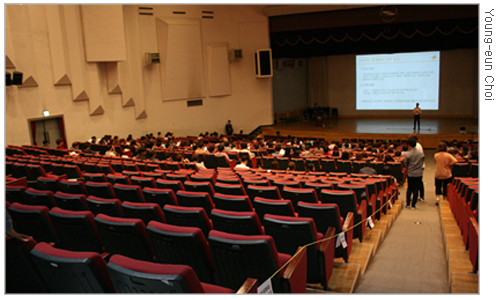
Students reacted to the MOE’s evaluation in a variety of ways. In a survey conducted by The UOS Times, 34.8 percent of students attributed our B rating to, what they termed, indolence of school officials. Some students reproached the administration for a seemingly complacent attitude, one that the student council had also pointed out in Gwangjang, the UOS online community. Rather than the UOS Administration, it was Close-up, this year’s Student Council that posted on their own analysis of the MOE’s evaluation methods and listed the challenges that the school faced. In the survey, students commented, “The UOS should have expressed their own stance to us directly, but not through Close-up.” Others pointed out the possible damage to the school brand, saying, “The effort to uphold the public value of communication turned out to be little help with UOS image or reputation, because it, at any rate, resulted in B. Therefore, the school’s explanation seems to be a mere excuse.” Some criticized MOE’s regulations and evaluation methodology rather than the administration itself. 39.1 percent of the respondents argued that the primary reason for the B rating remained unclear, and that the MOE did not have standardized criteria.

Without their interest in and empathy with the administration, students will easily hold the school responsible and doubt the administration’s earnestness. This distrust may arise, however, from the students’ ignorance of school business and values. This ignorance is the result of the lack of communication between administration and students. Apart from the administration’s own effort, student indifference is a major factor that blocks bilateral communication. These finally brought about a failure in students’ crafting the statement on the evaluation of RPU in the last General Student Assembly. In the last General Student Assembly, students failed to participate in crafting a statement on the MOE evaluation. The number of students who appeared in the meeting failed to even reach a quorum. The Assembly is a three-hour meeting held twice a year to report on and respond to essential school business, allowing students to participate in the policy-making process, and ultimately in forming the identity of the school and the student body. The passivity and low interest that students showed during the Assembly period indicated they were not internalizing the school’s visions and values.

Long-lasting development of the UOS necessarily demands the students’ full internalization of school identity because it leads to a true affection for the school, from which improvement of the school follows. In what may be termed a virtuous cycle, an improved school attracts students with a clearer identity and stronger affection. The University of Southern California (USC) proved this idea with a brilliant program. The USC hired high salaries of football coach and improved its college football league. Successful plays and a number of championship cups caused higher school attachment not only from undergraduates but also graduates. This led huge donation that made the USC took third place of the university. With the donation, the USC could give financial support to students, improving the academic environment. As a result, the USC went up from 51st place to 23rd place in the national university ranking. Besides, the reputation of the school was exceedingly improved.
The direction of college reform should be based on a school’s identity. The UOS has presented precious values, such as a commitment to society and innovative research that contributes to social values. However, these values will not be realized without students’ agreement and support. Like the case of the USC, the UOS needs the programs that reflect the common interest of the students and induce them to form a community. These programs will break down the walls of individualism that keep them apart from their school and will foster a culture that matches the school’s values. This will eventually raise the students’ sense of attachment or loyalty, and thus more of them will devote time and energy to the school’s development. For example, the school can provide incentives for the students who donate their talents to community programs. These programs help to fulfill the school’s social commitment and also supplement students’ finances. Through more community activities, a stronger bond will be created.
In the process of development, however, the UOS should think about its role as a public school. There are some who criticized the RPU (Restructuring Plan for University) evaluation for mostly focusing on social demands and giving higher scores to schools that train employees to fit the largest corporations. Won-seok Choi, deputy vice-president in the Office of Planning Affairs said, “It is hard to say that universities are trying to satisfy what the society wants from their students. Focusing on employment is also important. However, we, the community of the UOS as a public university, should preserve and develop the real meaning of higher education by protecting the minor departments and performing the duties that any university should fulfill, even if this does not meet the social demands that corporations require.”

On the bright side, according to the interview with Choi, the UOS administration has already ordered all departments to evaluate themselves internally and present their problems and possible solutions, so that the school can recognize and solve these problems together. This is not only for next RPU evaluation in 2018, but also in preparation for an upcoming student satisfaction survey.
However, no matter how attractive programs may be, or how the school is trying to gather more feedback for its reforms, nothing will be better without students’ interest and participation. Active participation and feedback is the only route for revamping the quality of education and school programs. The voice of the students will trigger a higher quality in student welfare and environment. U.S. President Barack Obama once said, “We, the People, recognize that we have responsibilities as well as rights and that our destinies are bound together.” Having responsibility means that students are attached to their school. Binding within a community is a process of internalizing and strengthening the school’s identity. The relationship between the students and their school determine what the school will become.
Official Kim said, “Rather than fighting and scolding each other, I think it is time to cooperate, contributing our strengths to improving the UOS.” Just as Kim said, unilateral action will not lead to any improvements of the UOS. Interaction, understanding, and good work by school officials and students together should become priorities. The results of the RPU evaluation must have come as a shock to many. However, instead of talking about whom to blame, the UOS community must find the problems and take the solutions that the RPU evaluation pointed out. The UOS will then have a chance to change and develop.
In-young Joung
deliverance4@uos.ac.kr
Young-eun Choi
emilyc95@uos.ac.kr

